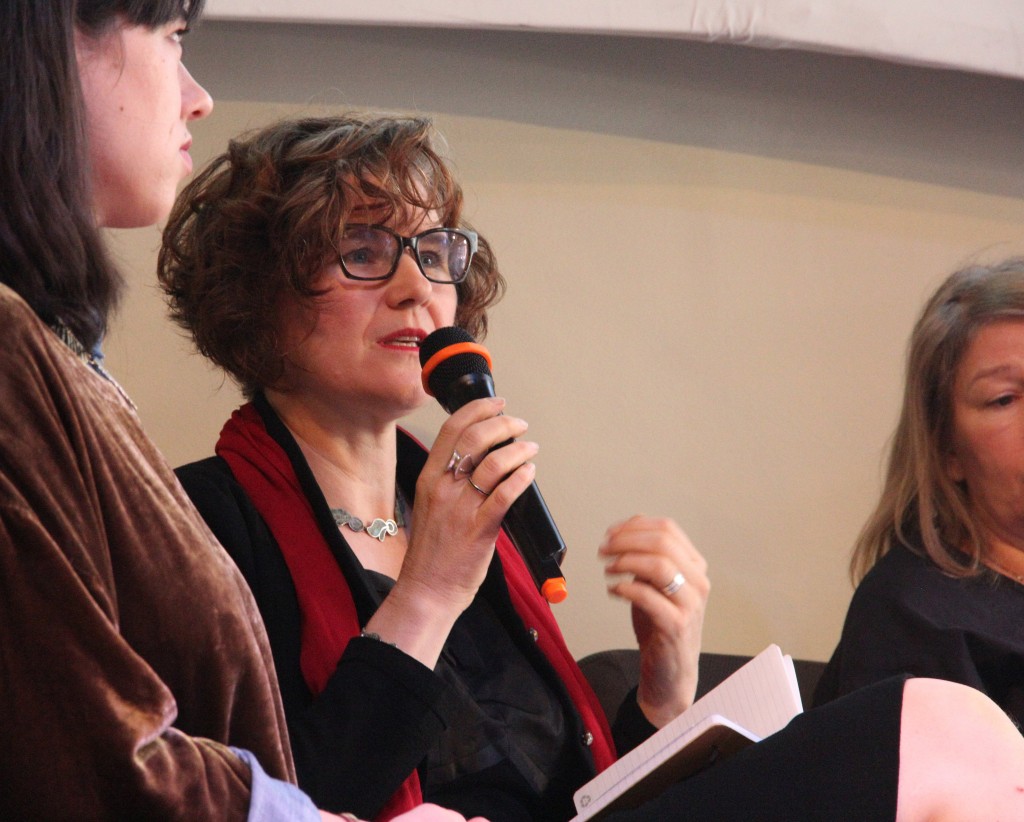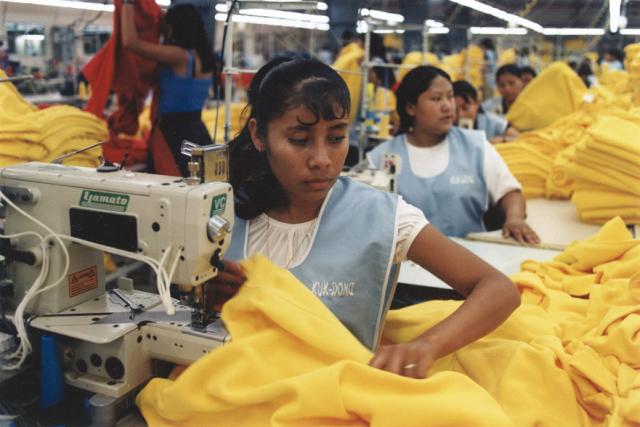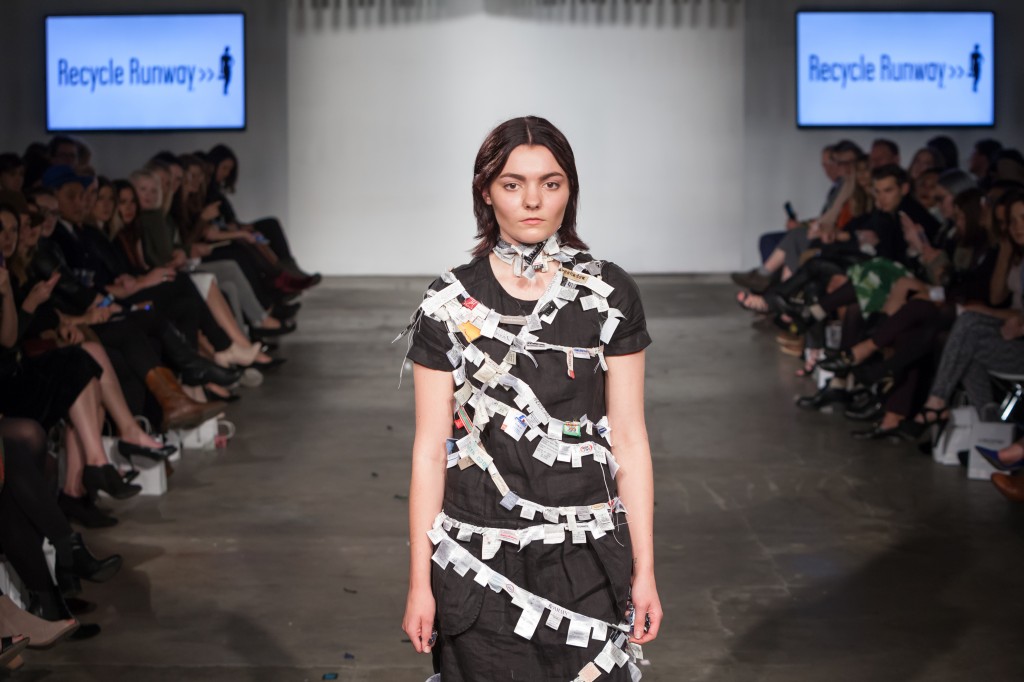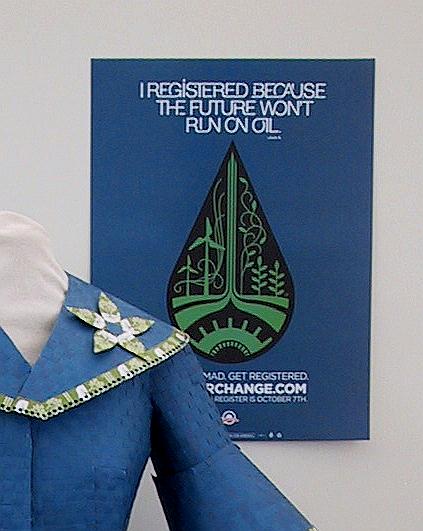Recycle Runway Blog
The Story of Fast Fashion, Waste, and Pollution
The second in my series on the true costs of the clothing we wear.

Speaking in the “Collective Conversation” panel at ECO FASHION WEEK about the cost of fast fashion.
In my first post of this series on the price of fashion, I explained how I took a deep dive into the environmental and social impacts of our clothing through preparing new work for last year’s ECO FASHION WEEK. We ended with the shocking fact that the fashion industry is the SECOND most polluting industry in the world after oil. Let’s unpack this statement in a little more detail.
Much of this pollution is traced to the enormous amount of waste the clothing industry generates in order to increase their profits. You might think the word “waste” is used to refer to the refuse created in the manufacturing process, and the 81lbs of clothing the average American throws away, that I mentioned in my first post. However waste is also distributed into the air, water and soil as pollution, during manufacturing. Another form of waste comes with the discarding, or exploitation, of people in this process. Three ways this industry is able to increase profits is by relying on the lack of oversight in developing countries; making clothing cheap; and adding micro-seasons or trends. This basically describes the concept of “fast fashion”, which has changed the ENTIRE clothing industry.
Developing Countries
The industry relies on the fact that many developing countries do not have the environmental laws in place that much of the western world has for industry. Without as strong legal protection for clean water, clean air, and toxicity the fashion industry saves money (and increases its profits) by sending its manufacturing to places like China, Bangladesh, and Mexico to name a few. These countries usually have fewer regulations for the protections of their workers too which results in low wages and poor working conditions. These are conditions that US companies have been taking advantage of since the 1990s when international trading agreements of opened up cheap global trade – we moved the sweatshops out of our backyard and into other countries. Many nations and their people are paying the price for our cheap fashion and its pollution. Of course nothing is all good or all bad, and there are people who have benefited from global trade for example, women who have been able to gain autonomy and help their families, sometimes even in respectful conditions. However, all too often working conditions are not fair or safe and US companies are taking advantage of social injustice to maximize their profits.

Photo by marissaorton, Sweatshop Project (CC BY-SA 2.0), https://www.flickr.com/photos/28876688@N03/2697297072
Making Clothing Cheap
When we talk about the new clothes we buy, we tend to focus on how inexpensive they are like: “I got this half price!” or, “I can’t believe I bought all this for $30.00!” or, “Le cheap, c’est chic…”1 Fashion design has fallen from the elite untouchable pedestal that it once stood on where the focus was what it was made from, who designed it, and where it was made. These are no longer of primary importance. The current focus on price, not design, means that our clothing is now reverse-designed starting with low cost as the goal. Interestingly by making clothing cheap, fast fashion, does have a way of democratizing the fashion industry but at the expense of what – people, environment, and planet? Are we literally buying into the very things that are harming us?
Micro-Seasons
Another factor to consider is that fashions used to be introduced four times a year; now “micro-seasons” have expanded into every TWO weeks, or 26 times a year! Stores such as H&M, Forever 21, and Zara, sell limited quantities of new styles only available for short periods of time which keep consumers coming back regularly so as not to “miss out.” Fast fashion’s very short lived trends require that people pay very little for clothing while encouraging frequent purchases. Because prices are so low, we accept sub-standard quality, making quantity over quality the norm. Our clothing becomes a commodity of decreased value. This is the fickle finger that switches the fate of clothing, allowing us to become capable of discarding 81lbs of clothing every year. As mentioned above, this new landscape has impacted the entire industry, making it difficult for most brands to offer affordable clothing that is beneficial or even neutral for the environment and people. I will explore the issue of what we can do, as consumers, in the final post of this series.

This dress, worn inside out to expose the stories underneath our clothing, is covered with hundreds of labels and tags, forming long “prayer flags”.
The photo above is of one of the pieces in my ECO FASHION WEEK collection. It is covered in hundreds of labels that tell part of the story of fast fashion. Clothing labels in addition to the price tags they are connected with tell us far more than just the brand, the designer, or the price. In fact, by revealing location, material, and cost they tell the stories of many of the issues we’ve just considered. What stories do you tell about your clothing? What might you guess from looking at the labels and tags in your clothes?
We will return to photos and more on my experience making my ECO FASHION WEEK collection and performance piece later in this series, meanwhile in the next post we’ll breakdown The Cradle to Grave Pollution Cycle of the Simple T-Shirt.
1Cline, Elizabeth L. Overdressed: The Shockingly High Cost of Cheap Fashion. Reprint edition. Portfolio, 2013. Print.
Morgan, Andrew. The True Cost | A Documentary Film. bullfrogfilms, 2015. SDH Captioned. http://truecostmovie.com/
For more details about fast fashion and its costs I highly recommend the two pieces referenced above.
This series was co-researched and co-written with Nicole Morris.
Photo Credits: Photos by Nicole Morris and marissaorton. Runway photo by Peter Jensen.








































